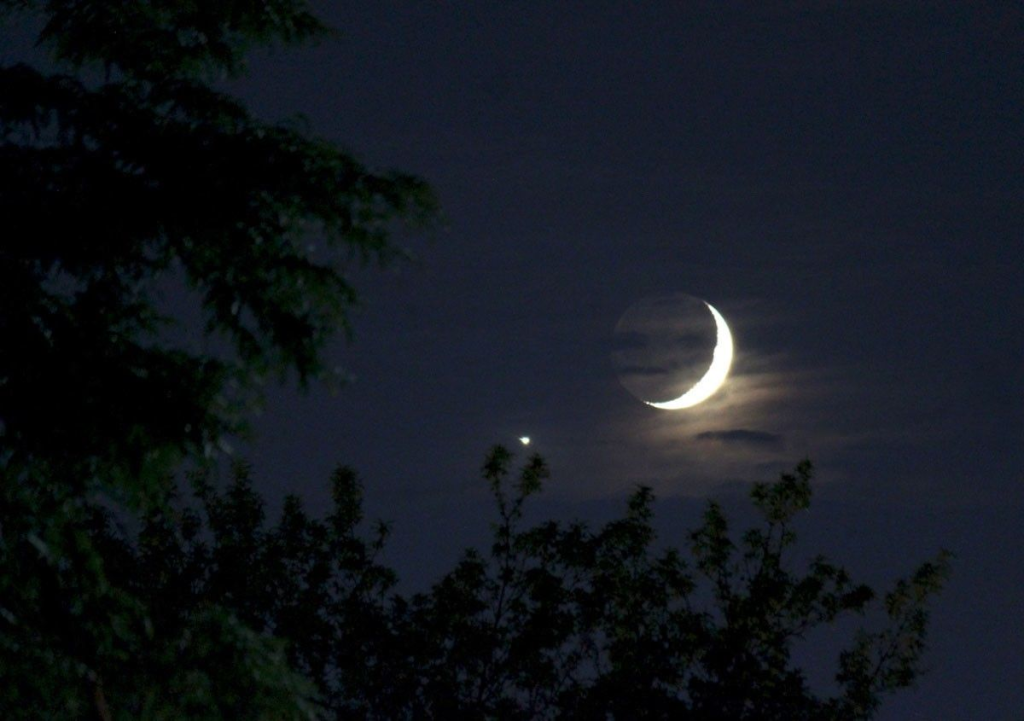
Mark your calendar for April 25, 2025 – sky watchers worldwide will witness an extraordinary celestial event as Venus, Saturn, and a crescent moon align to form what astronomers call a “cosmic smile” in predawn skies.
Many sky events demand special equipment or perfect conditions, but this planetary alignment offers a rare opportunity visible to anyone with clear eastern horizon access. Astronomical alignments involving multiple planets and our moon occur periodically, but arrangements that form recognizable patterns, like faces, remain uncommon and captivating events for observers.
What’s Making Sky Grin? Planets and Moon Align
A triple conjunction happens when three celestial bodies appear close together from our Earth-bound perspective. During this particular alignment, Venus will shine brightly as one “eye” above, with Saturn forming another “eye” slightly lower. A thin crescent moon curves below them both, creating a distinct smiling face pattern in a triangular formation.
“Venus is higher above the eastern horizon with Saturn lower, and a thin, crescent Moon a bit lower and a little farther north,” NASA Solar System Ambassador Brenda Culbertson told local Kansas TV station KSNT. “The thin, crescent Moon looks like a smile. To some people, the triangle of bright objects may appear as a smiley face.”
Venus ranks as the brightest planet in our solar system when viewed from Earth, appearing as a brilliant white point approximately 25 times brighter than Saturn during conjunction. Saturn, while less luminous, remains easily visible with its yellowish hue. Both planets will appear as bright points – planets do not visibly expand like discs to the naked eye, despite their actual sizes.
Your Guide to Catching the Smiley Face in the Sky

Viewing opportunities begin around 5:30 a.m. local time on Friday, April 25, 2025. Observers worldwide should prepare for early morning viewing, as this cosmic smile appears during predawn hours, regardless of their global location.
Viewing duration remains limited to approximately one hour before sunrise, as it diminishes visibility. Earlier arrival provides darker sky conditions for optimal contrast. Patience benefits observers – allow several minutes for eyes to adapt to the darkness for improved planet visibility.
Global visibility makes this event accessible worldwide, assuming cooperative weather. Metropolitan areas may experience challenges due to buildings obstructing low-horizon views. Rural or elevated locations, on the other hand, offer advantages for unimpeded visibility.
Mercury might make a bonus appearance for observers with apparent horizons. Mercury appears significantly lower than it does in primary formation and proves challenging to spot – consider it an additional prize if spotted, rather than a primary viewing target.
For Optimal Viewing

Success requires strategic preparation, starting with selecting the correct location. Ideal viewing spots feature completely unobstructed eastern horizons, with no trees, buildings, hills, or mountains blocking the view. Beach locations facing east, elevated areas, or open fields provide superior vantage points.
“Anyone wanting to try for a glimpse of the conjunction should find a clear eastern horizon from which to observe,” Culbertson said.
Light pollution significantly affects the quality of celestial viewing. Urban centers with excessive artificial lighting wash out fainter objects. Viewers should seek locations away from city lights when possible – rural areas, parks, or designated dark sky locations dramatically improve visibility. Light pollution maps available online help identify optimal local viewing areas with minimal light interference.
Weather conditions play a crucial role in viewing success. Clear skies remain essential – even thin clouds can obscure planets and crescents. Check the weather forecasts the day before the event and have backup viewing location options in case needed. Morning dew or fog often develops in some regions during the predawn hours – higher elevations usually remain above the low-level moisture.
Specific regional recommendations for North American viewers include:
- Eastern Seaboard: Ocean-facing beaches provide apparent eastern horizons
- Midwest: Open farmland areas away from city centers
- Mountain states: Lower eastern slopes with views over the plains
- West Coast: Elevated areas facing east over valleys
Viewing Equipment Options

Binoculars dramatically enhance the viewing experience without a significant investment. Basic binoculars allow viewers to distinguish planetary details and crater features along the lunar crescent. Recommended specifications include 7×35 or 10×50 binoculars stabilized against solid support for optimal viewing. Binoculars offer a perfect middle ground between observing with the naked eye and using a telescope.
Telescopes provide maximum detail for dedicated observers. Small amateur telescopes reveal Saturn’s rings, major phases of Venus, and detailed lunar features. Mars’ opposition in April 2025 means additional viewing opportunities for telescope owners beyond smile formation. Telescopes require more setup time – arrive early if bringing telescopic equipment.
Digital assistance through smartphone applications helps locate celestial objects precisely. Free astronomy apps, such as Stellarium, Sky Guide, or NASA’s Sky Watch, use the phone’s GPS and orientation sensors to identify planets through camera views. Download and test the selected app before the event day to ensure you’re familiar with the interface.
Family Viewing: How to Make Viewing Fun for All Ages
The cosmic smile event offers a perfect opportunity for introducing children to astronomy through accessible, visually engaging formats. Child-friendly explanations should focus on comparative sizes and distances using familiar objects. Venus appears to be the size of a marble, while Saturn resembles a small bead, from Earth’s perspective, despite their massive actual sizes.
Age-appropriate activities enhance educational value:
- Ages 3-6: Drawing a cosmic smile after viewing
- Ages 7-10: Simple planet fact matching games
- Ages 11-13: Basic photography attempts with supervision
- Teens: Research project on planetary movements
Safety considerations include wearing appropriate clothing for predawn temperatures, which often drop to their lowest point shortly before sunrise. Bring insulated blankets, warm beverages, and portable chairs for a comfortable viewing experience. Red-filtered flashlights preserve night vision while providing necessary illumination for movement.
Family preparation should include a pre-event introduction to planetary facts and expectations for viewing. Show children pictures of previous alignments and explain why early wake-up is necessary. Consider making the event memorable by hosting an “astronomy breakfast” after viewing or by following a special pre-bedtime routine the night before.
Photography Tips for Capturing Magic

Smartphone photography continues to improve but presents challenges for capturing astronomical subjects. Latest models with dedicated night modes offer possibilities unavailable a few years ago. Essential smartphone techniques include:
- Mount the phone securely on a tripod
- Use voice commands or a timer to avoid touching the device
- Manually adjust focus to infinity when available
- Reduce screen brightness to preserve night vision
- Take multiple shots with slight setting variations
Advanced camera settings for DSLR or mirrorless equipment:
- Raw format preserves maximum data for post-processing
- Manual focus set precisely to infinity using a bright star
- Aperture priority with the widest opening (lowest f-number)
- ISO settings between 800 and 3200, depending on camera capabilities
- Exposure times between 5 and 15 seconds, balancing brightness against star trailing
Composition strategies significantly impact final images. Include recognizable foreground elements to establish scale and location context. Position the horizon approximately one-third from the bottom following classic compositional principles. Wide-angle lenses (14-24mm) capture a broader celestial context, while medium telephoto lenses (85-135mm) isolate formations more dramatically.
Post-processing enhances subtle details that are often invisible in raw captures. Basic adjustments include contrast enhancement, shadow recovery, and selective brightness adjustments, which help highlight planets against a darker sky. Advanced techniques involve image stacking, which combines multiple exposures to reduce noise and increase detail.
Bonus April Sky Events

April 2025 offers multiple astronomical viewing opportunities beyond a celestial smile. Lyrids meteor shower peaks April 21-22 with optimal viewing between 10:30 p.m. and 5:00 a.m. local time. Expect approximately 10-15 meteors per hour under ideal conditions, with occasional brighter fireballs. Meteoric activity continues several days after peak – cosmic smile observers might catch occasional late Lyrid meteors during morning viewing.
Mars reaches opposition on April 19, 2025, appearing larger and brighter than usual throughout the month. The red planet remains visible throughout the night during the opposition period, with details observable through modest telescopes. Mars’ opposition occurs approximately every 26 months, making April 2025 a prime time for viewing.
The International Space Station offers multiple visible passes throughout April 2025. Online tracking resources provide location-specific viewing times for bright ISS passes. The station appears as a brilliant moving point crossing the sky in 3 to 5 minutes. Many passes occur during dawn and dusk periods when the station reflects sunlight, while observers remain in darkness.
Don’t Miss This Rare Sky Show!
April 25th offers a rare and beautiful sight: Venus, Saturn, and the crescent moon forming a shape like a smile in the early morning eastern sky, around 5:30 a.m. This isn’t a standard lineup, making it a moment worth seeing.
You don’t need special gear; this cosmic smile is visible with just your eyes. The viewing window is brief, about an hour, so getting ready ahead of time is key. Find a spot with a clear view east. Check the weather. Set an early alarm so you’re prepared for the day.
Consider the experience itself. While photos are lovely, simply watching the sky directly holds something special. Share the morning with family or friends; seeing the smile together can be a wonderful moment, perhaps sparking interest in the cosmos.
This easy cosmic greeting connects us with the wonders above. A little planning helps guarantee you’ll see this ephemeral celestial smile yourself. Be ready for this unique morning view.


